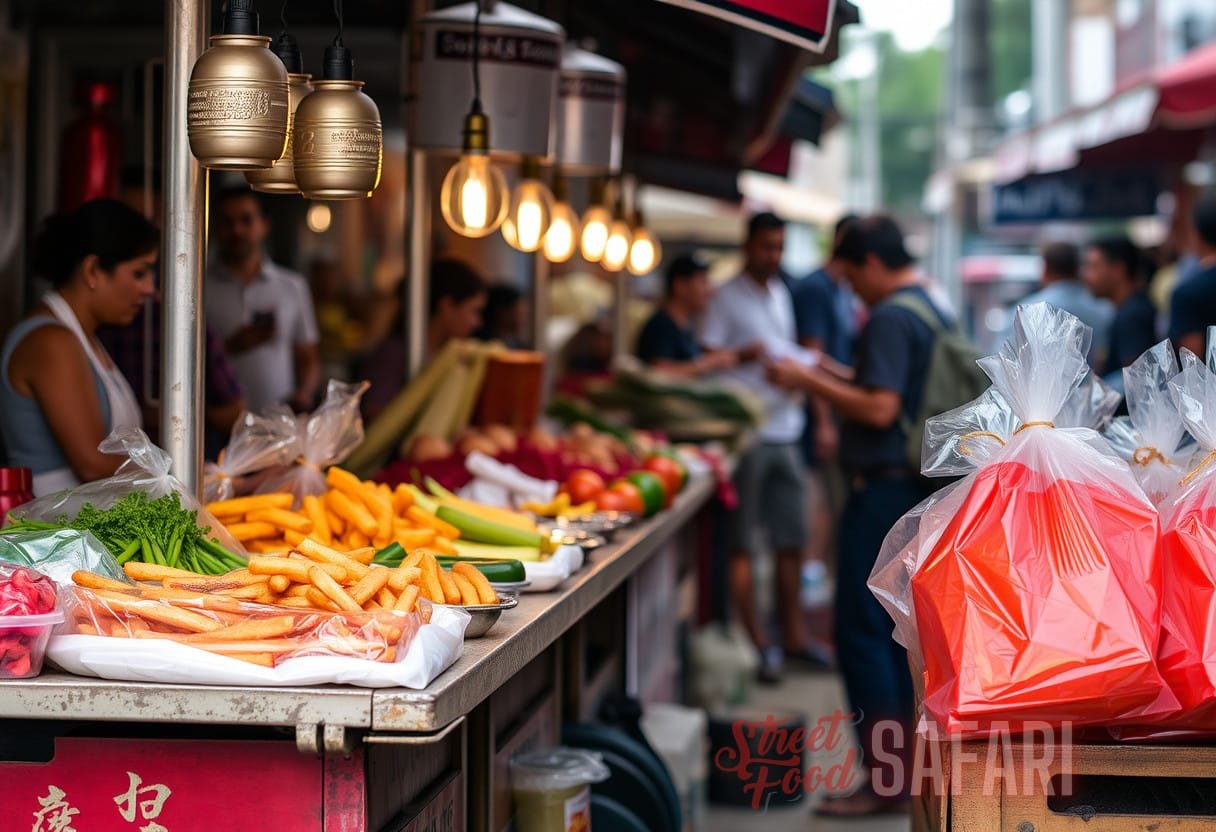Street Food Synergies: Investigating the Intersection of Culinary Science and Cultural Exchange
The concept of culinary street fusion reflects a growing trend in the food industry, emphasizing the intertwining of culinary science with cultural traditions. Street food is more than just a meal; it embodies the rich cultural narratives and significant historical influences of various communities.
The Evolution of Street Food
Historically, street food has played a vital role in urban life across cultures. In ancient Rome, vendors sold food products in public spaces, while in Asian countries such as Thailand and India, street food culture developed significantly over the centuries. According to the Food and Agriculture Organization (FAO), approximately 2.5 billion people globally consume street food daily. This statistic illustrates the monumental role street food plays in many societies. Street food not only provides an accessible fare but also serves as a microcosm of cultural exchange.
Understanding Culinary Science in Street Food
Culinary science is essentially the study of food preparation techniques, the chemical and biological processes that occur during cooking, and the innovation of flavors and textures. Street food, characterized by its robust flavors and textural contrasts, becomes an interesting terrain to explore culinary science principles. Some key points of interest include:
- The Maillard Reaction: This chemical reaction enhances flavor and aroma, crucial in grilling meats or sautéing vegetables.
- Emulsification: Found in sauces like mayonnaise, which involve a mixture of ingredients that stay combined, emulsification allows for creamy textures in street food.
- Fermentation: Techniques like kimchi or pickling not only preserve food but also introduce beneficial probiotics and distinctive tastes.
Street Food and Cultural Exchange
Street food acts as a vehicle for cultural exchange, creating a mosaic of food practices. The globalization of street food has led to a phenomenon where culinary street fusion is prominently featured. The following examples highlight how diverse cultures intertwine through street food:
Case Study: Tacos in the United States
The taco has transcended its Mexican roots, becoming a staple dish in various American cities. Food trucks have popularized numerous taco variations, showcasing a blend of flavors that often incorporate ingredients from different cultural backgrounds:
- Korean BBQ Tacos: This ingenious combination merges traditional Korean barbecued meat with Mexican tortillas, showcasing how culinary street fusion celebrates both cuisines.
- Vegetarian Tacos: Inspired by the increasing demand for plant-based options, many vendors now offer tacos filled with roasted veggies, grains, and distinct sauces, reflecting broader dietary trends.
Global Influences on Indian Street Food
Indian street food stands as a prominent example of culinary street fusion, enriched by historical trade routes and cultural exchanges. Some popular street food items highlight this blend:
- Pani Puri: This dish has evolved with regional variations, integrating local spices and ingredients influenced by neighboring countries.
- Chaat: A vibrant mix of flavors and textures, chaat exemplifies the amalgamation of culinary ideas from diverse ethnic communities.
The Role of Technology in Street Food Innovation
The advancement of technology has dramatically influenced street food, leading to the innovation of dishes and the emergence of food trucks. Vendors increasingly leverage online platforms to reach wider audiences, tailor menus, and uphold quality standards. This digital transformation reflects the changing landscape of street food culture:
- Mobile Apps: Applications that promote street food vendors enable users to discover local specialties easily, driving the popularity of culinary street fusion.
- Social Media: Platforms like Instagram serve as marketing tools for vendors to showcase innovative dishes and attract food enthusiasts.
Health Implications of Street Food
While street food offers diversity and convenience, it often raises health concerns regarding food safety and nutritional content. Studies indicate that up to 50% of street food vendors may not adhere to health regulations, according to the World Health Organization (WHO). Factors to consider include:
- Food Preparation Standards: High microbiological risks can occur during food preparation in non-compliant vendors.
- Nutritional Content: Street food often comprises high-fat, high-sugar options, leading to concerns about obesity and chronic diseases.
Local vs. Global Street Food Culture
Factors such as urbanization and international migration have significantly shaped street food culture, intricately weaving local customs with global trends. Cities like Tokyo, London, and Mexico City represent unique street food landscapes that illustrate localized culinary street fusion:
Tokyo’s Innovative Street Food Scene

Tokyo’s street food is a testament to Japan’s culinary precision and creativity. Vendors offer dishes that merge East and West, reflecting the city’s evolving tastes:
- Yakitori: Grilled chicken skewers paired with innovative sauces that change based on cultural influences.
- Fusion Crepes: These sweet or savory crepes incorporate global flavors, transforming traditional Japanese food into something new and exciting.
London’s Eclectic Food Markets
London serves as a melting pot of cuisines, making it a vibrant hub for street food enthusiasts. Markets like Borough Market feature an array of food stalls representing global flavors:
- Pakoras and Chaat: Vendors serve Indian snacks that cater to a diverse clientele, highlighting the culinary street fusion.
- Bratwurst Hot Dogs: German influences appear in various food stalls, showcasing how global flavors intermingle.
The Economics of Street Food
The street food economy is burgeoning, offering significant opportunities for entrepreneurs. According to research, street food can constitute over 6% of the food and beverage market globally, with a notable growth trajectory. Factors contributing to this economic phenomenon include:
- Low Start-Up Costs: Entrepreneurs face minimal overhead, allowing them to enter the food industry more easily.
- Flexibility in Location: Street food vendors have the advantage of mobility, adapting to consumer preferences by changing locations.
Case Study: New York City
New York City is notorious for its thriving street food scene. Food trucks range from classic hot dogs to gourmet offerings, contributing significantly to local employment and economic growth. Statistics from the City of New York indicate that street vendors contribute over $100 million in revenue each year to the city.
Sustainability in Street Food Practices
The increasing awareness of sustainability has prompted street food vendors to adopt eco-friendly practices. Crucial elements in sustainable street food practices include:
- Local Sourcing: Vendors prioritize locally sourced ingredients, reducing carbon footprints while supporting local farmers.
- Waste Management: Initiatives to minimize food waste, such as composting and using biodegradable packaging, are increasingly popular among vendors.
Global Initiatives and Local Impact
Organizations like the EAT Forum promote sustainability by supporting street food vendors worldwide in adopting best practices. The positive impact on communities includes improved ecosystem health, enhanced food security, and cultural preservation.
Regulatory Landscape for Street Food
The regulatory landscape for street food often varies significantly from one region to another. Compliance with health and safety regulations is crucial for vendors seeking to thrive in the street food market:
- Licensing and Permits: Vendors must obtain necessary licenses to operate legally, which can be cumbersome in some cities.
- Food Safety Training: Understanding proper food handling procedures is essential to mitigate health risks.
Case Study: Regulations in Singapore
Singapore is renowned for its strict food safety regulations, which have helped maintain a high standard for street food. The National Environment Agency (NEA) has implemented rigorous training programs for vendors, ensuring compliance and promoting public health.
Conclusion: The Future of Culinary Street Fusion
With the integration of technology, heightened awareness of sustainability, and cultural exchange, the future of street food seems promising. Culinary street fusion continues to inspire innovation and creativity, allowing culinary traditions to adapt in a contemporary context. The future potentially lies in the hands of emerging global food trends combined with local culinary artistry, offering a unique and delicious exploration of tastes.



